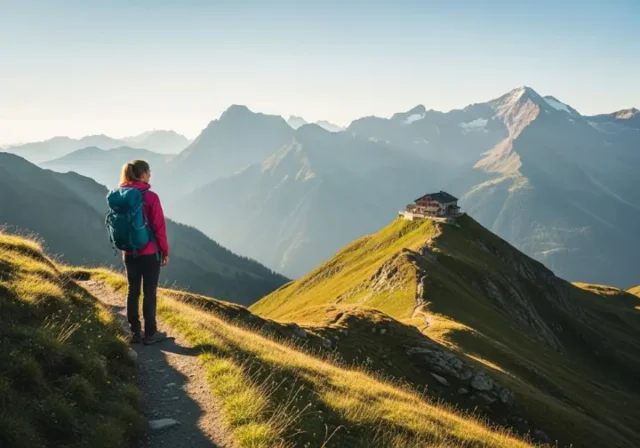In this article
The legendary hut-to-hut hike in Switzerland is a cultural tradition that unlocks the high Alps, but planning it can feel as formidable as the peaks themselves. This field guide demystifies the entire process, providing a comprehensive blueprint—from choosing the right season and routes to mastering hut etiquette and logistics—to empower you to plan and execute your Swiss alpine adventure with expert confidence.
What is the Swiss Hut-to-Hut Experience?
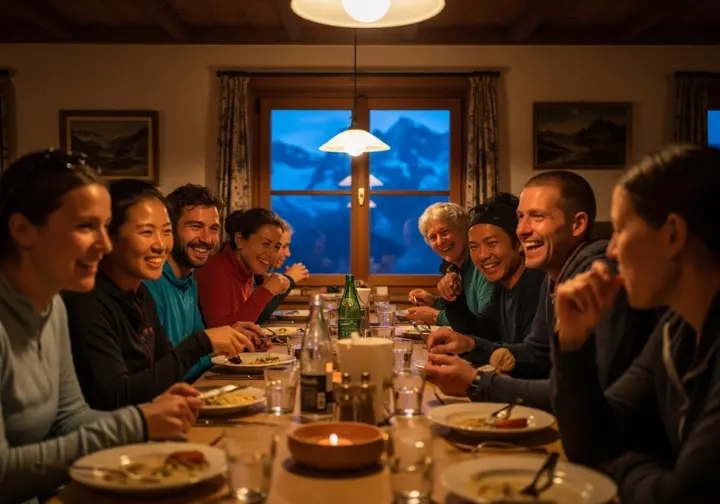
To understand hut-to-hut hiking in the Swiss Alps is to understand a rhythm of life dictated by the mountains. It’s about more than just walking; it’s an immersion into a system that makes the high country accessible, social, and deeply rewarding. It’s waking up to sunrises and unwinding to sunsets from the top of Europe.
What Defines the Hut-to-Hut Hiking Journey?
At its most basic, this hut-to-hut approach eliminates the need for a tent and other heavy camping gear. Each day’s hike concludes at a mountain hut, allowing you to carry a lighter backpack and focus entirely on the trail and the staggering scenery. This minimalist approach is a core part of the Swiss experience.
The journey is defined by a powerful sense of community. Huts are social places where hikers from every corner of the globe share stories, route tips, and a collective passion for the mountains. This fosters a unique camaraderie, born from shared effort and shared awe, that is difficult to find elsewhere. Newcomers can find a wealth of foundational tips for beginner hikers to get started.
A central element of this social fabric is dinner, often served in a bustling dining room. It is typically a substantial, three-course meal served family-style at a fixed time, bringing all guests together to refuel and connect. This tradition is a cornerstone of The history of alpine huts, transforming simple shelters into bastions of alpine culture and Swiss hospitality.
What is the Anatomy of the Swiss Mountain Hut Network?
The backbone of this system is the network of over 153 well-maintained huts managed by the Swiss Alpine Club (SAC), which was established in 1863. This incredible infrastructure, supplemented by numerous privately-owned cabins, supports a staggering 65,000 kilometres of meticulously marked trails across the country. The founding and mission of the SAC has been pivotal in shaping this Swiss alpine landscape.
A critical distinction exists between hut types. Staffed Huts (Bewartete Hütten) are the most common on popular routes, offering full service with a warden, hot meals, and bedding during the summer season. In contrast, Unwardened Huts (Unbewartete Hütten) are a basic shelter where you must bring and cook your own food.
These are not the primitive shelters of old. Modern mountain huts have evolved significantly, many now featuring sustainable technologies like solar panels for power and sophisticated water treatment systems. This evolution has made the high mountains more accessible to a broader audience, which is a key part of understanding Swiss hiking culture.
What is the Daily Life and Etiquette in a Swiss Hut?
Upon arriving, tired and triumphant, your first step is to leave your muddy boots and trekking poles in the designated boot room, or Schuhraum. You’ll then change into hut slippers (often a colorful array of provided Crocs) before checking in with the hut wardens. This simple act keeps the living quarters clean.
Sleeping arrangements are typically in a dormitory, the Matratzenlager, with mattresses arranged side-by-side. For hygiene, a personal sleeping bag liner, or Hüttenschlafsack, is mandatory. The hut provides warm blankets or duvets and a pillow. It’s a system based on shared space and mutual respect, governed by international reciprocal rights agreement for hut stays.
Amenities are functional and basic. Toilets and cold running water are standard, but hot showers are a rare, paid luxury. Electricity for charging devices is limited and highly coveted, so a power bank is a non-negotiable piece of gear. A strict daily rhythm is observed, with quiet hours (Hüttenruhe) beginning at 10 p.m. Most Swiss hikers are up and out early, fortified by a simple breakfast and “marching tea” (Marschtee) for their flasks, all while adhering to Leave No Trace principles.
How Do You Plan an Independent Hut-to-Hut Hike?
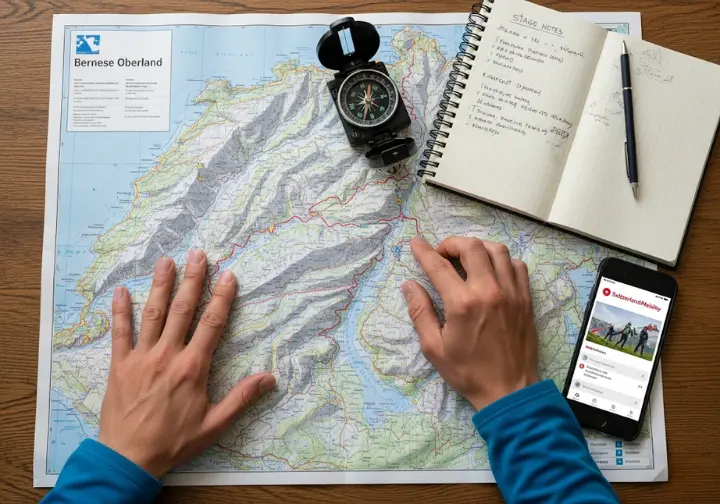
Successful independent trekking in Switzerland is a masterclass in logistics. It hinges on four pillars: timing your trip for optimal safety, building a realistic budget, packing an efficient and lightweight kit, and leveraging the country’s world-class transport network. Mastering these turns a daunting challenge into a manageable and thrilling project for your Swiss hiking adventures.
How Do You Choose the Right Hiking Season?
While the general hiking season runs from July to September, the reliable window for crossing high alpine passes (those above 2,500 meters) in these mountains is significantly shorter: mid-July to late August. This is the period with the highest probability of snow-free trails and stable weather across the diverse terrains.
A critical mistake is assuming that because huts open in mid-June, the high passes are clear. They are not. In late June and early July, many high-altitude passes hold dangerous, steep snowfields that require an ice axe, crampons, and the skills to use them.
Conversely, early September brings an increasing risk of the first winter snowfall. While this often melts quickly, it can create treacherous, low-visibility conditions. Hiking from late September onwards is reserved for experts with extensive alpine experience and a high tolerance for risk. Always consult the official Swiss mountain weather forecasts before setting out.
Hiking the Alps: Seasonal Conditions and Gear
Understanding the best time to hike based on snow conditions, hut availability, and required skill levels.
Typical Conditions
Valley trails clear; huts begin to open.
High Pass Status (>2500m)
Snow-covered and hazardous.
Required Gear/Skills
Mountaineering equipment (ice axe, crampons) and avalanche assessment skills required.
Best For
Experienced Alpinists Only
Typical Conditions
Rapid snowmelt; streams are high.
High Pass Status (>2500m)
Problematic snow may remain; sections may be impassable. Bridges may not be installed.
Required Gear/Skills
Standard gear plus potential need for ice axe. High risk tolerance.
Best For
Experienced Hikers
Typical Conditions
Warmest weather; longest days.
High Pass Status (>2500m)
Almost always clear of snow.
Required Gear/Skills
Standard hiking gear.
Best For
All Levels of Hikers
Typical Conditions
Stable weather but cooler; risk of first snowfall.
High Pass Status (>2500m)
Generally clear, but can be temporarily snow-covered after a storm.
Required Gear/Skills
Standard gear; preparedness for cold and low visibility.
Best For
Experienced Hikers
Typical Conditions
Colder; many huts closing.
High Pass Status (>2500m)
High probability of snow and ice.
Required Gear/Skills
Gear and experience for winter conditions are essential.
Best For
Experts Only
How Do You Budget for a Swiss Hut Hike?
Your primary daily cost is accommodation. A night in a SAC hut dormitory with half-board (a filling dinner and simple breakfast) typically costs between 70-90 CHF per person. Private rooms are sometimes available for a significant premium, but many hikers prefer the communal experience.
Food costs beyond half-board must be factored in. A packed lunch from the hut costs around 12 CHF, while a beer or soft drink can be 5-7 CHF. A more economical strategy is to stock up on lunch supplies like bread, cheese, and cured meats in the valley towns before you ascend.
Transportation is a major variable. The iconic red and yellow cable cars that shorten grueling ascents or descents are a welcome sight, but they can cost 20-50 CHF per ride. These must be included in your budget. For planning, the official Swiss public transport system website is an invaluable resource.
[PRO-TIP] Always carry sufficient cash in Swiss Francs (CHF). Many remote mountain huts, even popular ones, do not accept credit cards due to unreliable satellite connections. An SAC membership (from 80 CHF/year) provides substantial discounts and often pays for itself within a single week-long trek.
| Expense Category | Budget Hiker (CHF) | Mid-Range Hiker (CHF) | Comfort Hiker (CHF) |
|---|---|---|---|
| Accommodation | 35 (Dorm only/Camping) | 80 (Dorm with Half-Board) | 150+ (Private Room w/ Half-Board) |
| Dinner | 20 (Self-catered/Supermarket) | Included in Half-Board | Included in Half-Board |
| Breakfast | 7 (Supermarket) | Included in Half-Board | Included in Half-Board |
| Lunch | 10 (Supermarket) | 12 (Hut Packed Lunch) | 25 (Hut Restaurant Meal) |
| Snacks | 5 (Supermarket) | 10 (Supermarket/Hut) | 15 (Hut/Cafe) |
| On-Trail Transport (avg.) | 0-15 | 25 | 40+ |
| Miscellaneous | 5 (Drinks/Showers) | 10 (Drinks/Showers) | 15 (Drinks/Showers) |
| Estimated Daily Total | 82 – 97 | 147 | 245+ |
What Belongs on the Definitive Packing List?
The core philosophy is to travel light, with a target pack weight between 7-10 kg (15-22 lbs). A 30-45 liter backpack or rucksack with an integrated rain cover is the ideal size. Knowing how to properly pack a backpack for balance and comfort is a critical skill.
Essential on-trail gear is non-negotiable: broken-in waterproof hiking boots, trekking poles, a mandatory sleeping bag liner, a 2-liter hydration system, and robust navigation tools (a physical map from Swisstopo and compass backed up by a GPS device or phone with offline maps). A headtorch is crucial for early morning starts or navigating the hut after dark.
Your clothing must follow a layering system. This includes moisture-wicking synthetic or wool base layers (absolutely no cotton), a fleece mid-layer for insulation, and a fully waterproof and windproof outer shell jacket and pants. Hut-specific items include lightweight slippers for indoors, a quick-dry small camping/microfiber towel, cash, earplugs for the dormitory, and a power bank with the correct adapter for The Swiss national plug type.
Your Ultimate Hut-to-Hut Packing Tool
Packing for a multi-day trek can be daunting. Use our interactive checklist to review every essential item, from on-trail gear to hut-specific necessities. Check items off as you pack and download a PDF copy for your trip.
How Do You Navigate to Swiss Trailheads?
Switzerland’s public transport network—a seamless integration of trains, yellow PostBuses, and cable cars—is not just a way to get around; it’s an integral part of the hiking experience. It allows for unparalleled flexibility, enabling you to start and end treks in different remote valleys or mountain villages with logistical ease.
From Zurich Airport (ZRH), key trailheads are remarkably accessible. Hubs like Sargans for the start of the Via Alpina or Interlaken for the Jungfrau Region are reached by direct train in 1-2.5 hours. Reaching Chamonix for the Tour du Mont Blanc is more complex, often requiring several transfers.
From Geneva Airport (GVA), shared minibus transfers are the most efficient way to get to Chamonix, the base for the TMB and Walker’s Haute Route. The iconic car-free village of Zermatt, beneath the Matterhorn, is a spectacular ~3.75-hour train ride away. The journey itself is part of the adventure, and mastering digital route planning is a key skill for any independent hiker.
[PRO-TIP] Download the SwitzerlandMobility app. This is the single most indispensable tool for independent hikers, integrating detailed trail maps for the official national routes of Switzerland with real-time public transport timetables.
What Are the Most Iconic Hut-to-Hut Treks in Switzerland?
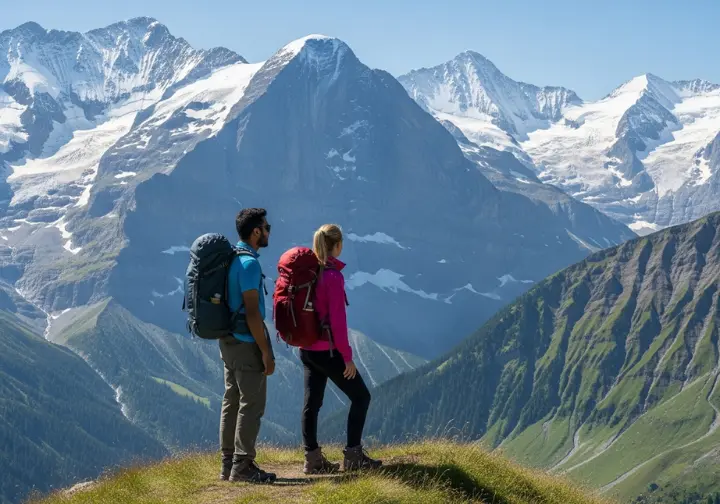
Switzerland offers a lifetime’s worth of trails through its pristine landscapes. Choosing a route requires an honest assessment of your fitness, experience, and what you want from the journey—be it solitude, iconic peaks, or cultural immersion. These “Grand Tours” are the pinnacle of the Swiss hut-to-hut hike experience.
Which “Grand Tour” is Right for You?
- Via Alpina (Green Route): This is the quintessential Swiss traverse, a 15 to 20-day journey celebrated for its epic scenery and cultural diversity as it winds through the heart of the Bernese Alps. It crosses lush alpine meadows and offers an ever-changing landscape. It is relentlessly beautiful and physically demanding (Difficulty: 4/5).
- Walker’s Haute Route: The high-altitude classic. This rugged 11 to 14-day trek connects two of Europe’s most famous alpine centers, Chamonix (Mont Blanc) and Zermatt (Matterhorn). It’s remote, wild, and suitable only for very experienced hikers comfortable with exposure and glacier crossings (Difficulty: 5/5).
- Tour du Mont Blanc (TMB): An international circuit that dips into France, Italy, and Switzerland over 9 to 14 days. It offers constant, iconic views of the Mont Blanc massif and has a vibrant social atmosphere. It is strenuous but less remote and technically demanding than the Haute Route (Difficulty: 4/5).
- Jungfrau Circuit: A highly customizable 5 to 10-day trek offering a concentrated dose of Switzerland’s most famous sights: the north face of the Eiger, the Mönch, and the Jungfrau. Its modular nature and excellent transport links make it adaptable for various skill levels. Much of this area carries a UNESCO World Heritage designation for its unique alpine landscape.
Comparing these legendary routes to other world-class thru-hikes helps to place their scale and challenge in a global context.
Swiss Alpine Treks Comparison
Explore some of the most stunning and challenging long-distance hikes in the Swiss Alps, from iconic traverses to high-altitude challenges.
Key Details
- **Distance:** 390 km
- **Total Ascent:** 23,500 m
- **Highest Point:** 2,778 m
Best For
The quintessential Swiss traverse, cultural diversity, and epic Bernese Oberland scenery.
Key Details
- **Distance:** 215 km
- **Total Ascent:** 15,000 m
- **Highest Point:** 2,987 m
Best For
High-altitude challenge, remote wilderness, and connecting Mont Blanc to the Matterhorn.
Key Details
- **Distance:** 170 km
- **Total Ascent:** 10,600 m
- **Highest Point:** 2,665 m
Best For
An international circuit with iconic Mont Blanc views and a vibrant social atmosphere.
Key Details
- **Distance:** 111 km
- **Total Ascent:** 12,000 m
- **Highest Point:** 2,969 m
Best For
Concentrated iconic scenery (Eiger, Mönch, Jungfrau) and high customizability.
Key Details
- **Distance:** Variable
- **Total Ascent:** Variable
- **Highest Point:** Variable
Best For
Unrelenting, dramatic views of the Matterhorn and high alpine thrills.
What Does a Premier Hut-to-Hut Trek Actually Look Like? (Day-by-Day)
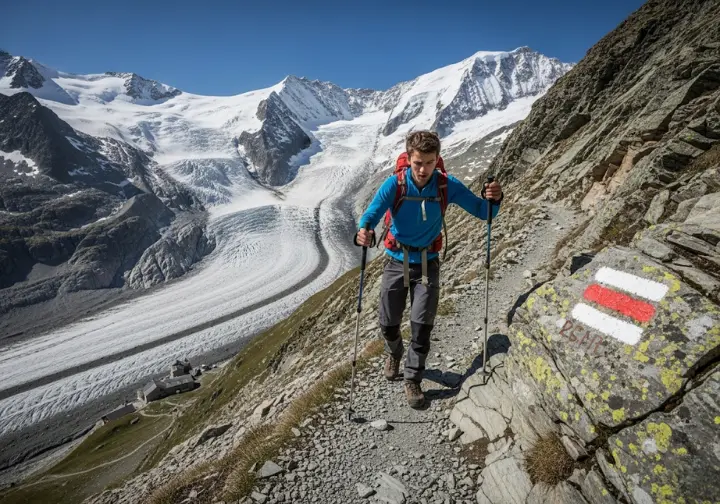
Statistics and descriptions can only tell part of the story. To truly understand the rhythm and reward of a Swiss trek, you have to walk the trail. This “Field Report” follows a classic 6-day hut-to-hut hike through the Bernese Oberland, a route that showcases the very best of the Jungfrau region’s dramatic alpine scenery.
Field Report: A Narrative Guide to the Jungfrau “Panorama Trail”
- Day 1: Schynige Platte to Berghotel Faulhorn. The journey begins with a vintage cogwheel train ride to Schynige Platte. The Panoramaweg, or panorama path, immediately unfolds onto a panoramic ridge with constant, breathtaking views of the Eiger, Mönch, and Jungfrau. The day’s highlight is passing the iconic Bachalpsee lake, its placid surface reflecting the snowy peaks.
- Day 2: Faulhorn to Glecksteinhütte. From the historic Faulhorn, the trail becomes a spectacular and exposed traverse high above the grinding expanse of the Upper Grindelwald Glacier. The destination, the Glecksteinhütte, is an eagle’s nest of a hutte, perched dramatically on a rock buttress with jaw-dropping glacial scenery from its sunny terrace.
- Day 3-4: Glecksteinhütte to Gspaltenhornhütte. These days are about transition. After descending, the route follows the famous Eiger Trail beneath the mountain’s formidable North Face, then crosses the deep Lauterbrunnen valley, passing small hamlets and areas of grazing cattle. The real challenge is the long, steep climb up to and over the challenging Sefinenfurgga pass (2,612 m) to reach the remote Gspaltenhornhütte.
- Day 5: Gspaltenhornhütte to Blüemlisalphütte. This is the “queen stage.” The day involves a grueling, mentally taxing ascent of the Hohtürli pass (2,778 m), the highest point on the Via Alpina. The reward is arriving at the Blüemlisalphütte, a stunningly located Berghaus sitting beside the vast, crevasse-strewn Blüemlisalp Glacier.
- Day 6: Blüemlisalphütte to Kandersteg. The grand finale. The trail makes a spectacular descent from the high, icy world of the glacier down past the otherworldly turquoise waters of Oeschinensee Lake. This final walk, through some of the most dramatic landscapes in the Alps, is an unforgettable conclusion to the journey. The lake is so special it has its own Oeschinensee Lake’s UNESCO status. Tackling such a route requires a solid base of essential hiking skills.
| Day | Start | End | Distance (km) | Ascent (m) | Descent (m) | Approx. Time (hrs) |
|---|---|---|---|---|---|---|
| 1 | Schynige Platte | Berghotel Faulhorn | 8.5 | 830 | 170 | 3-4 |
| 2 | Berghotel Faulhorn | Glecksteinhütte | 15.0 | 1,150 | 1,550 | 6-7 |
| 3 | Glecksteinhütte | Mürren | 18.0 | 750 | 2,400 | 7-8 |
| 4 | Mürren | Gspaltenhornhütte | 13.5 | 1,500 | 680 | 6-7 |
| 5 | Gspaltenhornhütte | Blüemlisalphütte | 8.0 | 1,200 | 800 | 5-6 |
| 6 | Blüemlisalphütte | Kandersteg (via Oeschinensee) | 13.0 | 150 | 1,800 | 5-6 |
What Are the Essential Rules and Resources for Success?
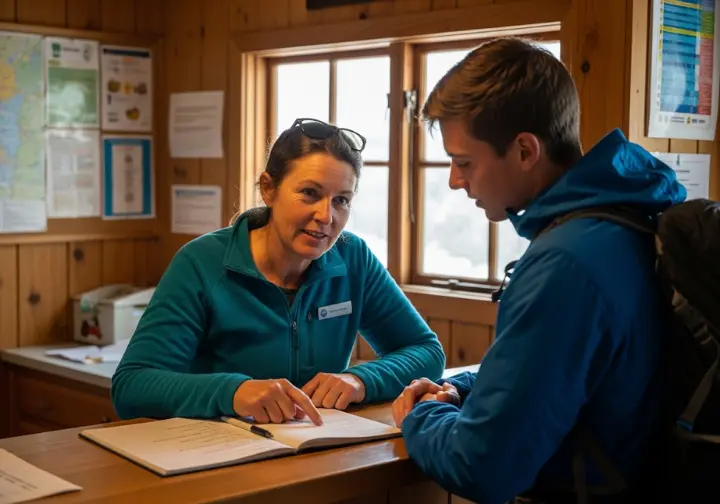
A safe and successful trek is built on a foundation of respect—for the environment, for the hut system, and for the raw power of the mountains. Mastering a few key rules and knowing your resources is not just good practice; it’s essential for any day hike Switzerland or multi-day adventure.
How Do You Master the Hut Booking System and SAC?
Advance reservations are absolutely essential, particularly for treks in July and August on popular routes like the TMB or Via Alpina. To book huts, you must act weeks, if not months, in advance as they are often sold out. Turning up without a booking is a recipe for disappointment.
Bookings are made through The SAC’s official route portal online or by calling the hut warden directly. Many wardens speak English, but being able to state your name, date, and party size in German or French is a respectful gesture to the hut owners.
A “no-show” is treated as a potential emergency and may trigger a mountain rescue operation at your expense. If your plans change, you must cancel your reservation in a timely manner. It’s a matter of safety and respect for the hut wardens who are holding a valuable spot for you. An SAC membership is highly recommended, as it provides discounts and reciprocal rights at huts in neighboring France, Italy, and Austria.
What are the Non-Negotiable Mountain Safety Protocols?
- Weather: Alpine weather is notoriously fickle. A bluebird morning can turn into a violent afternoon thunderstorm with frightening speed. Always check the mountain forecast from a reliable source like MeteoSwiss daily and be prepared for sun, rain, wind, and even snow at any time of year.
- Navigation: Trails are exceptionally well-marked with the iconic white-red-white flashes for mountain trails (T2/T3 difficulty). However, never rely solely on signs. Fog can descend in minutes, reducing visibility to near zero. Always carry a physical map and compass, and know how to use them, backed up by a GPS device or a phone with offline maps and a fully charged power bank.
- Emergency: The number for the official Swiss air-rescue service, Rega, is 1414. Have a charged phone and always inform the hut warden of your planned route for the next day. They are your first line of defense if you don’t arrive at your destination. Your gear should always include The Ten Essentials system to handle unexpected situations.
Conclusion
Successful hut-to-hut hiking in Switzerland hinges on meticulous planning, especially regarding season and hut reservations. The safest window for high passes is mid-July to late August, and bookings must be made well in advance. The experience is defined by a unique communal culture and a set of established customs, including mandatory sleeping bag liners, shared dormitories, and fixed dinner times. Independent hikers can execute ambitious treks by leveraging Switzerland’s integrated public transport system, which allows for unparalleled flexibility in route planning. Choosing the right trek—from the epic Via Alpina to the rugged Walker’s Haute Route—requires an honest assessment of one’s fitness, experience, and tolerance for remote, challenging terrain.
Share your own Swiss hut-hiking questions or experiences in the comments below, and explore our full library of Alpine trekking guides to plan your next adventure.
Frequently Asked Questions
How much does it cost to hike hut-to-hut in Switzerland?
A typical mid-range budget is around 147 CHF per person, per day. This covers a dormitory bed with half-board (dinner and breakfast), which costs between 70-90 CHF. The remainder accounts for a packed lunch from the hut (around 12 CHF), drinks, and an allowance for on-trail transport like gondolas or cable cars.
Is hut-to-hut hiking in Switzerland difficult?
Yes, most classic routes are physically strenuous and best suited for fit, experienced hikers. Trails frequently involve long days of 6-8 hours with significant elevation gain and loss, often over 1,500 meters (5,000 feet), on steep, rocky, and sometimes exposed terrain.
Do you need a sleeping bag for huts in Switzerland?
No, you do not need a full sleeping bag. However, a sleeping bag liner is mandatory in all Swiss Alpine Club (SAC) and most private huts. Huts provide warm folded blankets or duvets and a pillow, and the liner is required for hygiene in the shared sleeping spaces like the big dormitory.
How do you book mountain huts in Switzerland?
You must book huts well in advance, either through the official Swiss Alpine Club (SAC) online portal or by calling the hut warden directly. Due to high demand on popular routes with their basic rooms and dorms, walk-ins are rarely possible during peak season.



